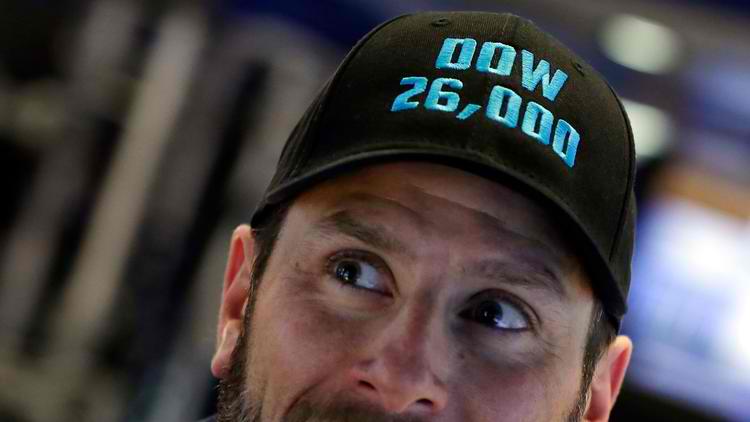
broad rally on Wall Street propelled the Dow Jones industrial average to close above 26,000 points for the first time Wednesday.
The sharp gains also delivered record highs for the Standard & Poor’s 500 index and the Nasdaq composite, wiping out the market’s modest losses from a day earlier.
Technology and healthcare companies accounted for much of the gains. Financial company stocks also rose, even though some big banks fell after reporting hefty quarterly losses.
“As yesterday’s pullback suggests, investors and traders will come back into a market in which they still see an upside,” said Quincy Krosby, chief market strategist at Prudential Financial. “But the market remains overbought, and an overbought market is susceptible to a pullback.”
The Dow climbed 322.79 points, or 1.3%, to 26,115.65.
The S&P 500 index rose 26.14 points, or 0.9%, to 2,802.56. The Nasdaq advanced 74.59 points, or 1%, to 7,298.28. The Russell 2000 index of smaller-company stocks increased 13.69 points, or 0.9%, to 1,586.66.
The Dow first traded above the 26,000-point threshold Tuesday, but it wound up closed lower that day. Its surge Wednesday was driven in part by a gain in Boeing, which posted the biggest advance in the 30-company average.
With the stock market reaching records so often, 1,000-point moves in the Dow have become increasingly commonplace. It has been just eight trading days since the Dow had its first close above 25,000. That’s faster than the 23 days it took the Dow to go from 24,000 to 25,000 points.
The stock market is off to a stellar start in 2018. The S&P 500 index has had a down day only twice this year. It capped last week with its seventh weekly gain in the last eight.
Investors have been encouraged by strong global growth, rising company earnings and the prospects for further corporate profits thanks to the tax overhaul signed into law last month, which cut the top tax rate for corporations to 21%, down from 35%.
Technology stocks were again some of the biggest winners. Lam Research led the S&P 500, climbing 7.7% to $205.08. Investors also bid up healthcare stocks, including Anthem. The insurer advanced 3.1% to $249.15.
Industrial stocks rose after the Federal Reserve said U.S. industrial production increased 0.9% in December. Boeing shares climbed 4.7% to $351.01.
Juno Therapeutics soared 51.9% to $69.25 after the Wall Street Journal reported that biotech drugmaker Celgene might buy it. Juno is one of several companies developing therapies that involve genetically engineering patients’ blood cells to fight cancer. Celgene fell 2.7% to $102.02.
Some big companies were left out of Wednesday’s rally.
Ford Motor slumped 7% to $12.18 — the biggest decline in the S&P 500 — after the automaker gave a disappointing profit forecast for the year because of weaker sales in the U.S., higher commodity costs and its investments in new electric and hybrid cars.
Goldman Sachs and Bank of America also fell; their latest quarterly results disappointed Wall Street.
Goldman said it lost $1.93 billion in the fourth quarter as the investment bank had to record more than $4 billion in charges related to the new tax law. Goldman’s trading desks had a weak quarter. The stock fell 1.9% to $253.65.
Bank of America’s fourth-quarter profit fell by nearly half compared with a year earlier as the bank had to book $2.9 billion in charges related to the tax law. The stock slipped 0.2% to $31.18.
U.S. crude rose 24 cents to $63.97 a barrel on the New York Mercantile Exchange. Brent crude, used to price international oils, rose 23 cents to $69.38 a barrel.
Gold rose $2.10 to $1,339.20 an ounce. Silver fell 2 cents to $17.17 an ounce. Copper fell 3 cents to $3.19 a pound.
The dollar rose to 111.13 yen from 110.30 yen. The euro fell to $1.2235 from $1.2271.
The price of bitcoin extended its slide Wednesday, though by late afternoon it had pared most of its losses from earlier in the day. The digital currency fell 1.6% to $11,172, according to the tracking site CoinDesk.
Bitcoin futures on the Futures Exchange of the Chicago Board Options Exchange fell 2.6% to $10,820. The futures enable investors to make bets on the future price of bitcoin. Many finance pros believe bitcoin is in a speculative bubble that could burst any time.
Heating oil futures rose a penny to $2.07 a gallon. Wholesale gasoline rose 2 cents to $1.86 a gallon. Natural gas climbed 10 cents, or 3.3%, to $3.23 per 1,000 cubic feet.
European markets finished lower. Germany’s DAX lost 0.5%, and the CAC 40 in France and Britain’s FTSE 100 both declined 0.4%.
Japan’s Nikkei 225 index lost 0.4%, and the Kospi in South Korea shed 0.3%. Hong Kong’s Hang Seng rebounded from earlier losses to gain 0.3%.

